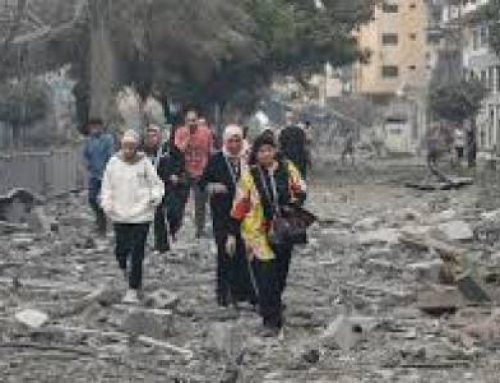The Atonement Academy school of Our Lady of the Atonement Parish in San Antonio, Texas, sent their package of letters1 from every child in their school to the children of the Latin Patriarchal school in Ain Arik of the Palestinian Territories.
The Atonement Academy school of Our Lady of the Atonement Parish in San Antonio, Texas, sent their package of letters1 from every child in their school to the children of the Latin Patriarchate school in Ain Arik of the Palestinian Territories. The Principal, Dr. Stephen Hollingshead, and the teachers of Atonement had to struggle with how to guide the children in reaching out to a people in a far off land during a time of international crisis. For the people of Ain Arik, it is a time of extraordinary suffering with the Christian community just striving to survive. For the people of San Antonio, it is a time of national resolve and of living under a shadow war against terrorism. The Texas teachers struggled with this difference along with the cultural differences inherent in a communication between American and Arab communities during this time of war. In the end, they determined to let the Holy Spirit lead them in a natural flow from the hearts of their children.
Dr. Hollingshead led the package with a letter to his counterpart, Principal Mirvat Shamali of Ain Arik. Dr. Hollingshead thanked Ms Shamali for the ongoing communications between the schools and for the joy it brought to the students. He inquired as to ideas for a service project that the American students might be able to do for her students during Lent. Atonement parish had sent a check to cover child sponsorship grants for every class in Ain Arik registered with the HCEF Child Sponsorship Program for Christian Education Support in the Holy Land, but he was looking for something more that the children might do to make the connection more personal.
With elegance, Dr. Hollingshead continued: “We understand that it is both a privilege and a burden for you to live in the Holy Land. In the Prayers of the Faithful at our school’s daily Mass, we pray especially for those suffering in the Holy Land, so we think of you often. In a way, the Holy Land belongs to all Christians, since our salvation was worked out there. By maintaining a Christian community there, you earn the gratitude of Christians everywhere. Your work of evangelization in the Holy Land is the best hope for peace; only the Christian doctrine of mercy can overcome the logic of revenge that pervades the politics of your region. I hope it is some comfort to you to know that our prayers are with you.”
The package sent along with the letter included 10 large envelopes containing letters written by each of the children from pre-kindergarten through eighth grades at Atonement Academy. The pre-kindergarten class sent two group photographs, one with the teacher, Mrs. Castello, and the other with her helper, Eve Waugh. They wrote: “I hope our letters will bring you as m
The kindergarten class teacher, Mrs. Terri Harrold wrote a letter to her counterpart: “My Kindergarten Class has read your 
The first grade had a form letter printed out with spaces where the children could enter their names, age, favorite subject, and one thing they like to do such as “play witny freks”, “fiestexas”, “swim”, “marbles”, and “go to mass”.
The second graders followed the same pattern as the first graders (or could it be vise versa). On
The third graders are advanced beyond form letters, and all wrote free style. They are very patriotic and have many American
Miss Holloway, the teacher for the fourth grade, had hers and each of the children’s pictures taken and taped to their composed letters. Each child also drew and attached a separate drawing sheet. The first impression is that these are very patriotic children. Each of them drew American and Texas flags along with slogans such as “In God we trust” and “United we stand.” Each child introduced themselves and told about their families and their hobbies. Other sentiments included: “The best thing I could ever do is be cool.” “I like to skate in the wrek room.” “I have a dog and three mice. I used to have fourteen mice.” “My teacher’s name is Miss Holloway. She is really smart.” “I may say so myself, I love to sing.” “I hope you get peace in Ain Arik and we are praying for you.”
The fifth grade children no longer draw: they compose under the direction of Mrs. Love. As did the fourth grade, the fifth 
The sixth graders are happy to write again; after all it’s not rocket science, or is it? Laura writes “Well, school started up again. It is still hot though… Here in Texas, we go swimming for fun… I also like to go into the woods and play… I cannot wait 
Judging from the letters of the seventh and eighth graders, the big event in San Antonio this summer was the scorching heat. The children write: “Here, it is very hot. One way to escape the heat is to go to a pool, river, or lake.” “Here in San Antonio, the heat of the summer is upon us – triple digits! Our only escape is that of a pool or sprinkler nearby.” “I went to Fiesta Texas… to ride lots of water rides!” “It is really hot here! It is almost 100 degrees.” “It is really hot with lots of moisture in the air.” “I am really getting tired of all the hot weather.”
How will the children of Ain Arik interpret hot? Ain Arik is in the lee of the Palestinian mountains. The valley that Ain Arik is nestled in opens up to the desert of the Jordanian valley. Hot is something these children know. Their houses are built of concrete and the natural limestone of the mountains, and hold the heat at bay with their sheer mass. The children only dream of pools, rivers and streams, since the occupation has resulted in the seizure of all water resources. The people of Ain Arik are allocated water only on one day per week by their occupiers. The people hold their water allocations in makeshift tanks on top of every home, and use them sparingly.
Finally, the children of Atonement Academy say: “Thank you so much again for your letters! I appreciate it so much!” “I cannot wait to get another letter from you!” “Write back soon!” “When you write back tell me all about your family and friends.” “Write back as soon as you can!”
Friends forever!
1 Beacons of Hope Program of the Holy Land Christian Education Foundation (HCEF). This program encourages partnerships between Christian schools in America and in the Holy Land.






